Experience Points – Memories of a Lifelong Gamer is a series of blog posts that I’ve undertaken to record some of my fondest memories of nearly 40 years of gaming.
Side Quests
The main entries in my Experience Points series will be about my experiences progressing through the various periods of video gaming in a mostly chronological fashion, from generation to generation. But every so often, I want to pause for a moment and take a Side Quest to talk about a more specific subject that is closely related, but that branches off from the Main Quest.
Yes, My Dad Liked Video Games
Some of them anyway.

One of the early games I got for the Atari 2600 in 1987 was Atari Football, first released the year I was born, 1978. It was a humble effort at a game that somewhat, mostly resembled American Football, if you squinted hard and suspended disbelief. Regardless of its dissimilarity to the actual sport, it was a fun game that my whole family enjoyed playing, even my mom! In fact, as I recall, she was the best of all of us at Atari Football.
We would all huddle around the 19″ TV in the kitchen (the black and white TV had been replaced by a COLOR TV before I had gotten my Atari in 1987) and take turns playing each other at Atari Football, where there were only three plays, and when you moved the joystick, it moved the whole team. At least the game did have the ability to score a Safety, along with a very sad sounding four-note jingle.
It turns out that my dad enjoyed video games too, as long as they were a simulation of something he enjoyed in real life, in particular football and auto racing, but occasionally a few others.
Football Games
My dad and I played a good bit of Atari Football, until the day I got to borrow Real Sports Football from my friend Mike. Then we switched to this much better football video game.
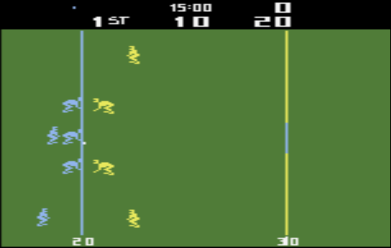
The game features a full 100 yard field, a few different types of offensive plays, defensive play choices, an updated scoring system and faster gameplay. Best of all, you controlled only one player instead of the whole team, like you did in the original Atari football. It definitely felt more realistic and my dad and I had a lot of fun with it.
Until I broke the game. No, I don’t mean I broke the cartridge, but I found a game breaking strategy that was 100% effective against the computer, to where I could win a 15 minute game by a score of over 200+ to 0. I had a pass play that always worked, was indefensible, and resulted in a touchdown easily. My dad, unfortunately, could also not stop it and I couldn’t think of a way either. So unless I purposely avoided this tactic, the game was useless to us.
Thankfully in 1988, Doug Neubauer, the author of Star Raiders and Solaris, came through with a very late and very good football game for the Atari 2600. It was called Super Football. My dad and I found this sometime shortly after it was released.

This was an extremely well done football game for the 2600. There were many play options, kickoffs, and much more realistic, competitive and fun.
It wasn’t unusual for my dad and I to play multiple games in a row, discover new plays and strategies and have to switch things up when one of us figured out how to stop the other. Neither of us found any game breaking glitches or strategies and it was always competitive.
There was one funny part of this game that I remember. When you selected your play, you had to scroll through a list of numbers. What that meant is that your opponent could see exactly which play you picked. So we had an agreement that we wouldn’t look at the screen during play selection.
That would be the last football video game we played together, however it would not be my last. But that’s for another article.
Racing Games
There was a time that I was a NASCAR enthusiast. It was a very different time in those days. It was the late 80’s and 90’s, so I got to experience some of the better NASCAR days (at least in my opinion). I had seen Bill Elliot set speed records at Talladega and Daytona that have never been broken, followed by the restrictor plate controversy. I saw the tire wars between Hoosier and Goodyear. I remember when there were still Oldsmobiles and Buicks in the field. I watched Richard Petty race live before he retired. I had the unfortunate experience of seeing two of my favorite drivers, Davey Allison and Alan Kulwicki, die in their primes. And I saw Dale Earnhardt aggressively cheat to win victory, after victory. “Intimidator” just meant that he could get away with dangerous tactics that nobody else was allowed to. Why pass when you can just hit them, destabilize them at 170 mph and then drive by? If NASCAR was professional wrestling, Dale Earnhardt was the top heel. And NASCAR took advantage of it, just like the NWA did with Ric Flair and WCW did with Hollywood Hulk Hogan (more on wrestling in a future post).
Racing was something that almost my whole family enjoyed. My sister, not so much. But my parents, my dad and grandfather and aunts, uncles and cousins were all NASCAR and racing fans. When we visited my dad’s side of the family, there was almost always a NASCAR conversation at some point, even in the off season. Sometimes we would just listen to my grandfather tell stories of the races that he saw over the decades. I can still remember some of these myself.
Not only did we go to a few NASCAR races, but we also went to a lot of local short tracks throughout Ohio and a few in Michigan. I found those just as fun as NASCAR, even though the names weren’t known very far outside the region. One of these was ARCA legend and Michigan/Ohio superstar Joy Fair, who always drove a yellow car with the number “1”. He had won hundreds of weekly feature races all over the midwest, but had been most successful in Ohio and Michigan. I was lucky enough to watch him race a number of times, including seeing one of his last feature victories at Flat Rock Speedway, at an age of over 70 years old.
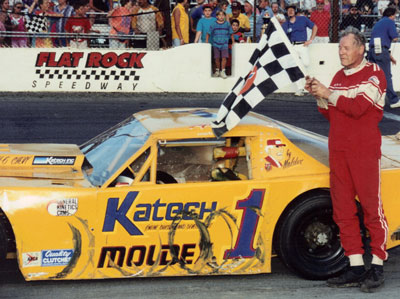
Eventually, my dad even got his own street stock and we were a short track racing team ourselves. We even won “Pit Crew of the Year” award for our very first season, as the officials had seen us dutifully taking tire temperature and pressure measurements after every practice and qualifying session, carefully timing every lap and making repairs to the car when we had a bad weekend.
Racing has always kind of been “in my blood”, and racing games would come to be among some of my favorites. But it all started in the late 80’s.
I was very surprised when one day my dad came home with a new Atari game. It was something he had found and wanted to play himself, which I thought was really cool. It was a game called Sprint Master.
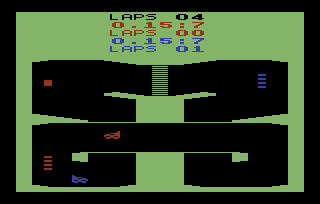
Sprint Master had 9 different track configurations, all single-screen, three different racing surfaces of varying traction (asphalt, dirt and ice) and two modes: bounce and crash. You didn’t really crash, however. It was basically just a bounce that lasted longer while a “crash” animation played.
My dad and I played countless games of Sprint Master, and not always multiplayer. It wasn’t unusual for my dad to play races on his own. We played all the different track configurations and even played around on different surfaces.
The next one we played was another acquisition found by my dad, Activision’s Grand Prix. Grand Prix was less of a racing game, and more of a memorization game. In Grand Prix, your goal was to finish each straight line course in as little time as possible. Hitting other cars, and driving over oil slicks slowed you down. Some of the cars you had to pass were almost as fast as your car, and some much slower, so the patterns took time to figure out and in some cases required some very precise movement to minimize the time. It was fun, but in the end, was not a great racing game in the way my dad and I wanted it to be.
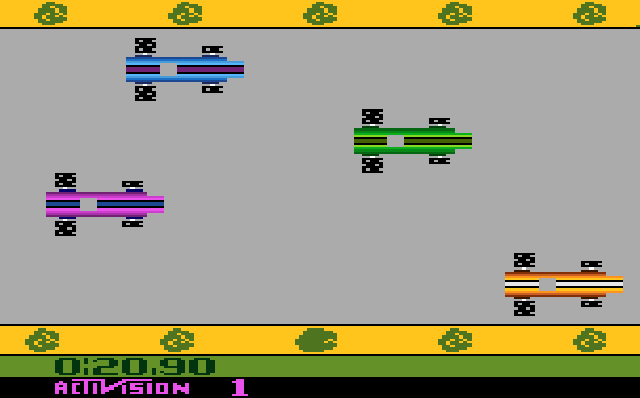
There was one more racing game that my dad not only purchased himself, but that was the most fun we ever had playing a racing game together. I’m getting a little ahead of myself in chronology here, but it belongs in this article. This was several years later, sometime near the mid 90’s and by this time I had a Super NES. One day my dad came home with a new racing game, Nigel Mansell’s World Championship Racing.
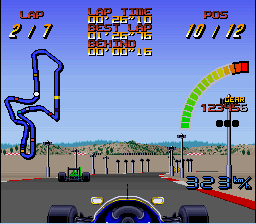
The 1990’s was a really exciting time for Formula 1. Even my dad and I were paying some attention to it. Some of the most legendary drivers were having fierce battles at this time, including Ayrton Senna, Alain Prost, Michael Schumacher and of course, Nigel Mansell. The McLaren Honda, Benneton Ford, Williams Renault and many other great teams took to the legendary courses of the Formula 1 Grand Prix, such as Suzuka, Imola, Monaco, Silverstone, and Spa Francorchamps. I even remember when Ayrton Senna was killed during qualifying at Imola.
It was very different from NASCAR, so I wasn’t sure how to follow it. The sponsors were different, the car brands were different, the names were so foreign, yet this gave it an air of the exotic. This wouldn’t be the last time I would be interested in F1.
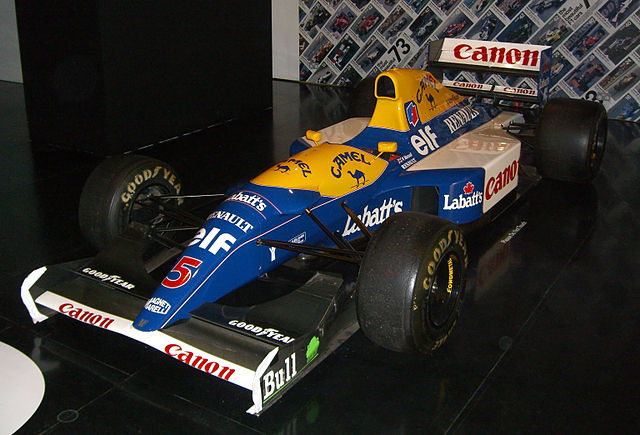
Nigel Mansell was riding high on his F1 championship victory, in the Williams Renault, one of the most technologically advanced F1 cars ever to take the field, with many electronic and technological assists and advancements It is no surprise that he was given the opportunity for a game of his own on the 16-bit systems of the time.
This game was very good for its time. The courses were replicated very well considering the technology, and when I later got back into F1, I was familiar with many course layouts due to the game. My dad and I enjoyed many hours running time trials, trying to improve our lap times, learning the courses. There was just SO much to do. Even more, you could use some basic car settings, such as tire softness, aerofoil downforce and transmission gear ratio to optimize the car for each course. My dad and I loved it, and reveled in our ability to make these small changes and achieve better lap times and race results.
We worked together far more often than we competed. We raced complete seasons with each other, taking turns in each race, and writing down the passwords we needed to pick up where we left off.
Wait, that last part might need explaining.

There was a time before you could save your games. In the Atari days, you simply started from the beginning any time you had to restart the game. In the NES and early SNES days, some games gave you passwords, which looking back were really data values that translated into the key bits of information needed to keep track of the game state. Games like Metroid, Mega Man and Castlevania allowed you to resume your game with the password. And so did Nigel Mansell’s World Championship Racing. I had a sheet of notebook paper filled with passwords that I recorded after each Grand Prix.
Over time, I played the game more often and got better than my dad. He still had a lot of fun playing on his own, but in terms of sheer skill at the game, I was getting ahead. In fact, I started my own season on a higher difficulty. The AI was harder and the races longer. but one race was giving me a lot of trouble, and I just couldn’t win it.
The Belgian Grand Prix, at Spa Francorchamps, one of the most legendary courses in the sport, was giving me fits. I just couldn’t seem to get the podium, and I knew I needed to in order to win the season. My dad noticed this and proceeded to start coaching me. We started with practice sessions, where my dad saw where I was losing time and he helped my improve my lap times by seconds. Then came the race itself. He advised what tires I should use and told me when to come in to the pit for refueling and a tire change. My dad was like a crew chief. As the race started winding down, he would keep giving me words of advice and encouragement. I just listened and kept driving. Before I knew it, the race was over and I had won! This was definitely a memorable video game moment for me. One that I’ll never forget.
But the greatest achievement of all, was with neither a racing game nor a football game.
Chopper Command
I’ve mentioned a few times how much I loved Atari’s Defender. It is probably what I would call my first favorite video game. But there was a challenge to Defender, by the competing developer, Activision.
A little bit of history is in order here.
Atari was very secretive about some things in their days as the leader of the home video game industry, one of which was the names of their developers. Atari never credited their developers in the games or manuals, as they feared other developers may head-hunt them and rob them of their developer talent.
This turned out to be a bad idea, as many of the Atari developers wanted the world to know they were doing the work, developing the world’s favorite games. One Atari developer, Warren Robinette, went so far as to create one of the video game industry’s first Easter Eggs in his game Adventure. This would later become a major plot point in Earnest Cline’s Ready Player One. Other developers, however, took a more drastic path. They left Atari and formed their own development company, which they called Activision.
Activision would go on to become the most successful 3rd party developer for the Atari 2600, as well as other consoles such as the Intellivision and even computer systems like the Commodore 64. This was how they were able to survive the crash of ’83. One of the reasons for their success was their ability to create clones of popular games that were as good if not better than the original. They were also good at developing their own successful games. Here are just a few magnificent Activision treasures on the Atari 2600:
- Pitfall and Pitfall 2
- Kaboom!
- Grand Prix
- Enduro
- Keystone Kapers
- River Raid
- Stampede
- Barnstorming
- Seaquest
- Freeway (Frogger clone)
- Megamania (Space Invaders clone)
- and of course, Chopper Command

Chopper Command is an example of a Defender clone that is just as good as the original. The goal was to pilot a chopper and protect the trucks at the bottom of the screen from being bombed by the choppers and planes. The more that were left when you cleared a level, the more points you got. Wave after wave, the enemies kept coming, getting faster and more aggressive. They eventually zipped around at very high speeds, hard to target and easy to collide with, let alone be hit by their fire.
My dad and I loved this game. We would both play it for hours on end, and as a result we started to get really good at it. Eventually we got to a point where the difficulty couldn’t get any higher, so we just kept racking up points. We would take turns after each round, giving our hands and forearms a much needed break. One day this just kept going and going. We were unstoppable, wiping out each wave of enemies like it was nothing. We kept this up for over four hours, as our score kept increasing. 100,000. 500,000. 750,000. We wondered how high it would go.
Then we found out. At 999,999 the game simply stopped. We had run the score as high as it would go. We “beat” Chopper Command, or as close as you can get to it.
Ladies and gentlemen, this is no small feat. I didn’t realize it at the time, but Chopper Command is known for its merciless difficulty. I’ll put it to you this way.
At the time, Activision offered high score patches for those who achieved a particular score, You had to take a photo of the screen and Activision would send you a cloth patch that you could attach to a jacket or shirt. Most likely by the time my dad and I beat Chopper Command, Activision was no longer offering these. But Chopper Command was difficult enough that they would send you a patch for scoring over 10,000 points. And we had gotten a million.
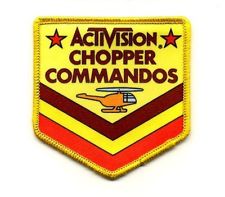
Each of us went on to replicate this achievement on our own, which means we both more than earned our own Chopper Commando patch.
I think this, of all memories playing video games with my dad, is my favorite. Dad, if you’re reading, thanks for the great times playing football, racing and definitely Chopper Command. You were a video gaming badass, one that even today’s modern gamers would struggle to match. Even if it was only for that one game.
Wrapping Up the Atari Years
I played my Atari quite a bit for the six years from 1987 until 1993. I played many more games than I’ve even mentioned in the Experience Points series thus far. I don’t have time to write about them all, but without a doubt, the Atari 2600 was one of the most memorable periods of my video gaming life. My mom (and I) definitely got her money’s worth, and I still enjoy playing some of those games.
But the slow march of technological progress continued. I would have no choice but to notice and play games for, the Nintendo Entertainment System. See the details next time in Experience Points Level 3.

Can’t wait for level three!